Date: 10/12/2015
Writer: Jane Moorman, 505-249-0527, [email protected]
LAS CRUCES – New Mexicans love green chile. As that love expands regionally and nationally, the New Mexico growers are faced with an increasing problem – labor.

Unlike red chile that is harvested mechanically, green chile benefits from the human touch, because broken fruits are undesirable.
“Green chile is a very labor-intensive crop,” said Stephanie Walker, New Mexico State University’s Extension vegetable specialist. “At harvest time, picking crews usually go in at least once, usually twice to hand-pick the fruit.”
This workforce has decreased by 5 percent since 2002, according to New Mexico Chile Association President Dino Cervantes. “We need more product; we can grow more product, but we can’t find the people to harvest it.”
During years when labor has been scarce, or when growers have not been able to get a large enough crew when the chile was at its peak, a field may go unpicked, which is a serious economic loss for the growers.
Mechanized harvests could eliminate this problem.
“As with other crops, moving to mechanization for the green chile is a challenge and something we are researching here at NMSU,” Walker said. “The question is, can we get a machine, a variety of chile and field management all coming together to give us an efficient, clean mechanical harvest of green chile?”
In previous years, researchers at NMSU have worked with the U.S. Department of Agriculture’s Ag Research Service to find the perfect machine.
“We have tested many different machines, many different picking heads, to see which one would work best on green chile harvest,” Walker said. “We think we have found it.”
The machine that has given the researchers minimal damage to the harvested fruit is a machine that is manufactured in Israel by inventor Elad Etgar.
“The machine is used in that country’s chile industry, and is now being field tested in New Mexico,” Walker said. “It is working very well on our crops.”
As a result, NMSU has purchased a one-row, small-plot machine to do experiments at its agricultural science centers to fine-tune the variety and field production protocol to come up with the best scenario for a good, clean mechanical harvest.
Walker and graduate student Chuck Havlik conducted two studies – a variety trial and plant spacing experiment – this year at NMSU’s Agricultural Science Center at Los Lunas.
“We looked at six different breeding lines and commercial cultivars that we picked with the machine to see if different plant attributes impact the efficiency of the mechanical harvest,” Walker said. “We measure many different attributes of the plants in the field prior to harvest, and then aspects of the fruit after the harvest, such as the number of fruit successfully picked and the quantity remaining on the plant and ground.”
Plant spacing may also help get a more efficient mechanical harvest.
“In red chile, which is almost all mechanical harvested, we have found that closer spacing tends to make the plant taller and brings the fruit up off the ground. These plants feed into the machine better,” Walker said. “We would like to take what we’ve learned with red chile and apply it to green chile.”
The issue is that if the plants are too close together, it can impact the size of the chile pod.
“With green chile the fruit size is critical; everyone wants a nice big, solid fruit to make their chile relleno,” Walker said. “If the plants are very close together, it may hurt the quality of the fruit.”
The researchers tested planting four, six and 12 inches apart to see the impact on the fruit and harvesting.
Another big challenge with mechanical harvesting is the destemming of the pod. When crews are hand-picking the chile, the stems are removed at the same time the fruit is harvested.
“Having a stemless fruit is important for the processing plants’ product flow,” Walker said. “If we mechanically harvest the green chile, we need a mechanism to destem the fruit.”
NMSU recently joined forces with Nag Kodali, who worked on destemming chile in his native country of India.
“He has come up with a very efficient, straightforward mechanical method of destemming,” Walker said of Kodali, who now lives in New Hampshire. “Early field testing is proving successful.”